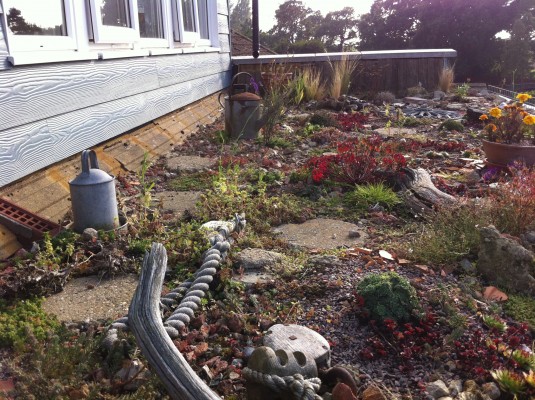Bringing biodiversity to a green roof in Essex
Gay in Jaywick came to one of our workshops some years ago. I also often bump into Gay at events such as Ecobuild. Over the last few years she has been sending me great pictures of her little green roof empire in Essex.
Green roof on Extension
Gay says ‘…the extension was built traditionally but we made sure the architect knew that we were putting a green roof on it. It was designed in order that it could take the extra load and was completed in May 2012.
We did not put the green roof element on until a year after in June 2013, as we wanted to be sure that the building was perfectly sound and watertight first.
We purchased the first edition of the guide and opted for a biodiverse green roof that would provide a habitat similar to a brownfield site. This has varying levels and areas of different materials and should attract various insects and birds.
Green roofs can be expensive! The roof measures 2m by 7m and it would have cost in the region of £2,000 to have the whole thing done professionally. We bought in underlay, butyl liner and root protector from butyl products. This cost £350 in total and was quite easy for one person to lay.
We were quoted between £230 – £400 for the substrate but instead patiently over the year broke up all the waste brick from the build along with shredded bark that we had been saving. Soil and old compost has been added to this. In the end we paid nothing for substrate.
We had been saving and splitting up plants for months and have added to them over the year. There are lots of sedums, houseleeks, alpines etc. along with wild flowers and random plants that have just ‘arrived’. We probably have splurged £20 on a few new plants. We will add a few more, as they are very beneficial to wildlife but apart from that for now we just want to leave it alone and see what develops. ‘
Green roof on the Shed
The shed is 8′ by 12′. This green roof was completed in April this year (2014). We used the same principles as we did with the extension. Extra strong 4” by 2” beams to take the weight then traditional roofing felt followed this time by old carpet, butyl liner, root protecting liner, old brick, bark and compost and then reclaimed plants.
The shed itself is a mix of old and new. Some new wood and other materials had to be used, but the double glazed units are from skips, the insulation inside is scrap offcuts from a professional installer. The roof and floor boards are OSB boards that were used to surround the building site of the new Aldi store in Clacton.
Biodiversity on the roof – 2014
Luckily it has been a wet summer and both roofs have established really well. There is good access to the house roof from our bedroom window so I have done a little weeding of tap roots. The birds come each day to drink from the chicken feeder. We have chaffinch, robin, blue tit, wood pigeon, collared doves and a wren driving us mad the other morning. The roof is full of nooks and crannies for insects, logs, rope, chain, old tiles and bricks. We also have had lots of bees.
I put a couple of pots of pansies followed by pot marigolds for a splash of colour.
There are many plants including;
chives, stipa, many sedums, evening primrose, icelandic, field and other poppies, valerian, mind your own business, moss, corncockle, herb robert, feverfew, london pride, lettuce!, dead nettle, hare and hound, achilia, daisy, various thyme, mesembryanthemun (phew!) These are bright pink and have flowered all summer on both roofs, blousey but beautiful. I have plans for many more ‘insect specific’ plants but just letting things happen for now.
We love our roofs! Everyone who visits has a look and think they are great. The guide was invaluable!’
So if you want to bring a bit of biodiversity to a roof near you check out the new Second Edition of Small Scale Green Roof Guide.

